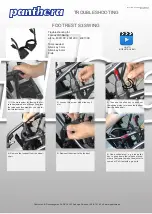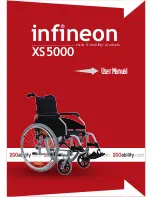
38
Quickie Jive
12.0 batteries and charging
warnIng!
Please read the owner’s manual with the charger
•
supplied carefully. The general procedures and
effects for the interference with the chair and the
batteries remain valid.
Do not expose any part of the battery to direct heat
•
(i.e. naked flame, gas fire).
When charging always place your charger on a hard
•
surface in a room with good ventilation.
You should not charge your batteries in outdoor
•
conditions.
12.1 batteries
The batteries are contained within the drive unit located
under the battery shroud.
To remove the batteries first release the two handle
screws under the front of the seat frame (Fig. 12.1),
(Fig.12.2 MWD), which connect the seat frame with the
seat module interface.
Flip the seat frame backwards until the automatic lock pin
clicks to secure it in place, (Fig. 12.3 and 12.4). Ensure
the seat is secure before letting go.
Lift off the battery box lid.
Disconnect the 2 pin Anderson connectors from each
battery (Fig.12.5 and 12.6).
There are straps available on each battery to facilitate
lifting them out. Remove the front battery first.
To fit the batteries reverse the above procedure.
12.2 safety cut-outs
In the event of a short circuit there are several safety
systems built into your wheelchair to safeguard your
electrical circuits, (Fig.12.7).
1. Fusible 150A links are connected into the battery
harnesses to protect the batteries and wiring.
2. 15A auxiliary power circuit fuses for auxiliary modules
and the Recaro seat power supply
To replace them contact your Sunrise Medical authorised
dealer, who will also diagnose the fault.
12.3 common battery statements
Over the years, battery technology has moved forward
but, unfortunately, some of the advice given on battery
care has not. This has resulted in a number of confused
and at times contradictory instructions on the ‘best’ way
to care for your batteries.
This section will help to dispel some of these myths and
legends.
Batteries are the power source for almost all of the
modern mobility products available today. The design
of batteries used in mobility products is significantly
different to the batteries used to start a car for example.
Car batteries are designed to release a large amount
of power over a short period of time, whilst mobility
batteries (commonly called deep cycle batteries) release
their power evenly, over a long period of time. Therefore,
due to the lower production volumes and increased
technological requirements, mobility batteries are
typically more expensive.
Commonly two 12 volt batteries are used together in a
mobility product, giving a total voltage of 24 volts. The
size of the battery (e.g. its available power) is expressed
in amps per hour e.g. 70amp/hr. The higher the number,
the bigger the battery size, weight and, potentially, the
greater the distance you can travel. Sunrise Medical only
fit as standard maintenance free batteries into these
types of wheelchairs.
cautIon!
Do not fit car batteries to the wheelchair. Fit only deep
cycle, maintenance free mobility batteries.
fig. 12.1
fig. 12.2
fig. 12.3
fig. 12.4
fig. 12.5
fig. 12.6
When the batteries are worn out, take them to the local
authority disposal point.
















































